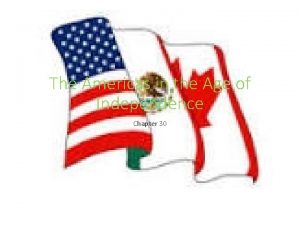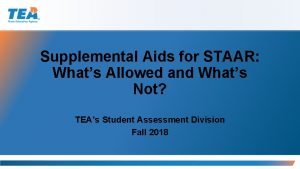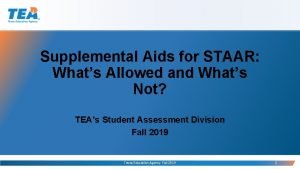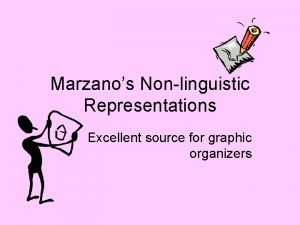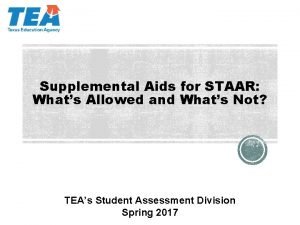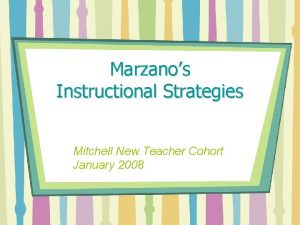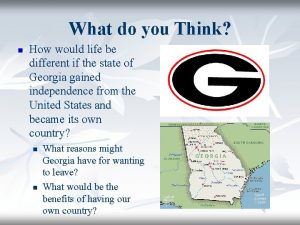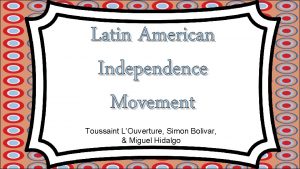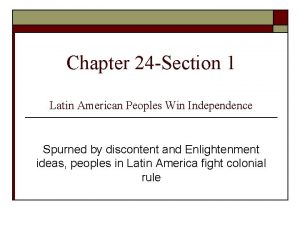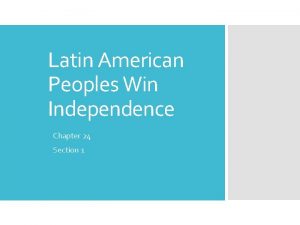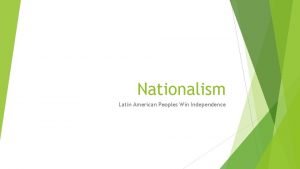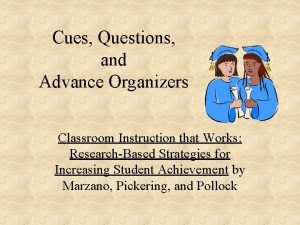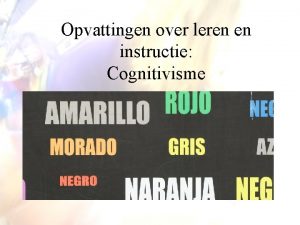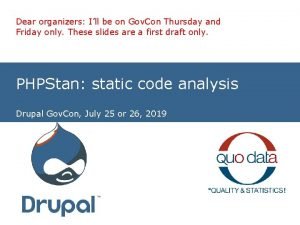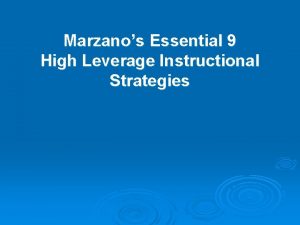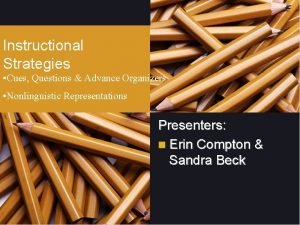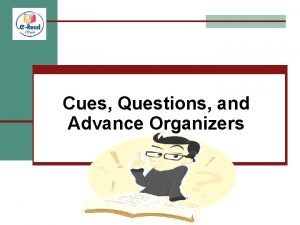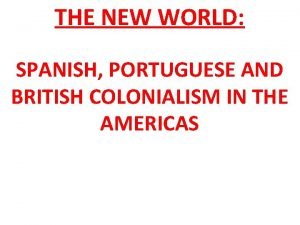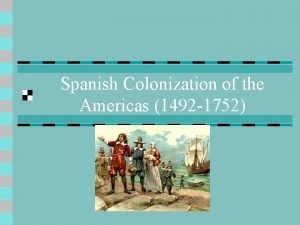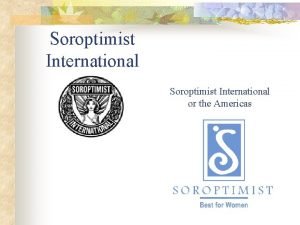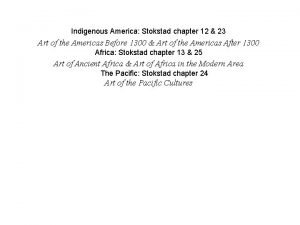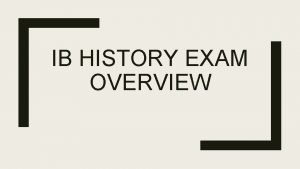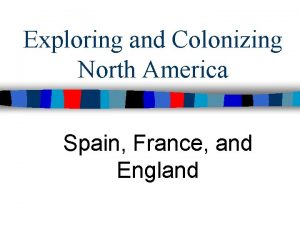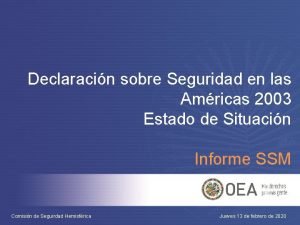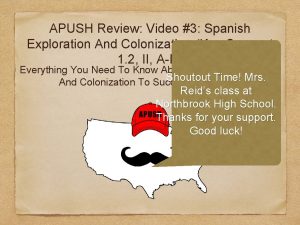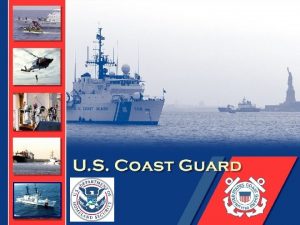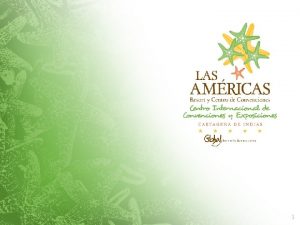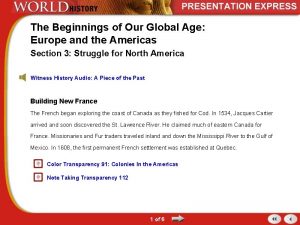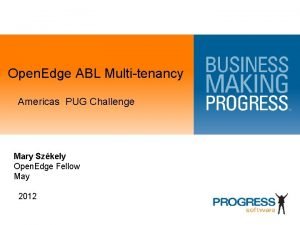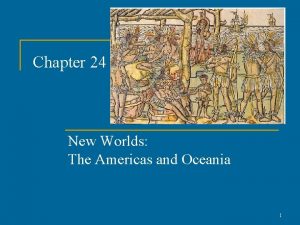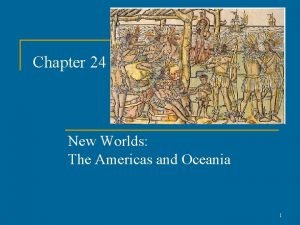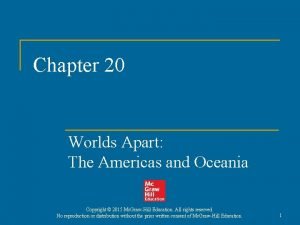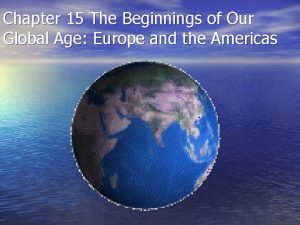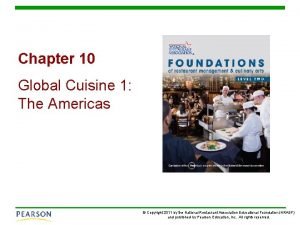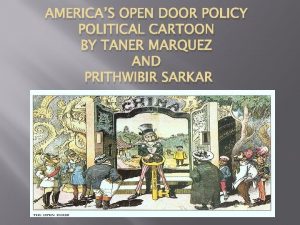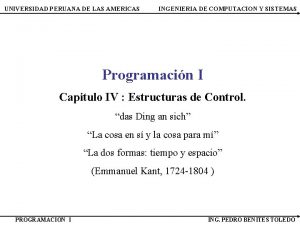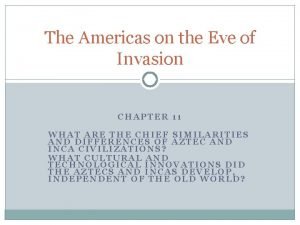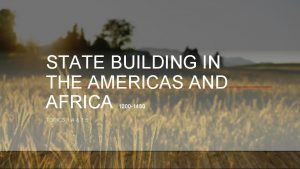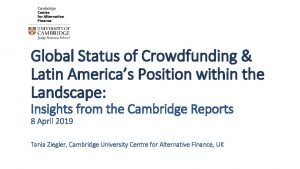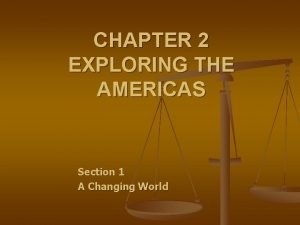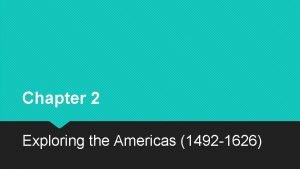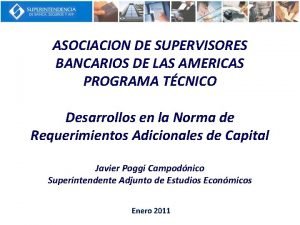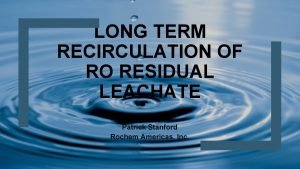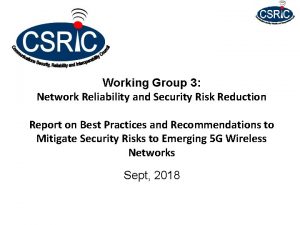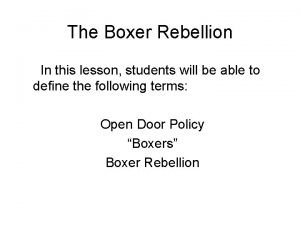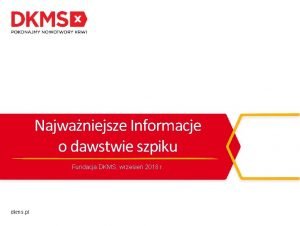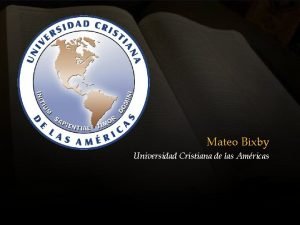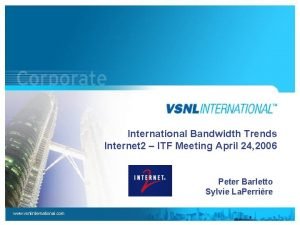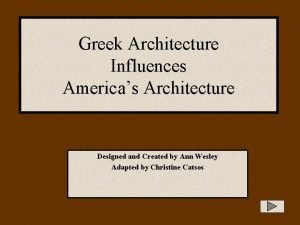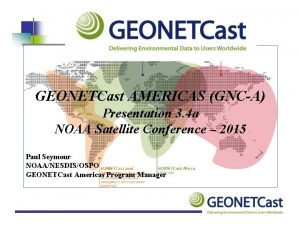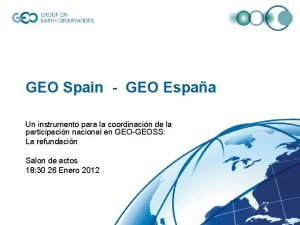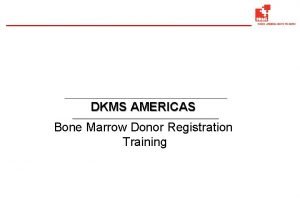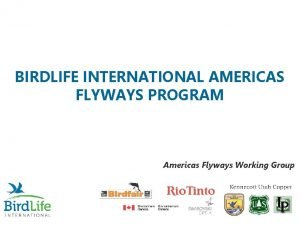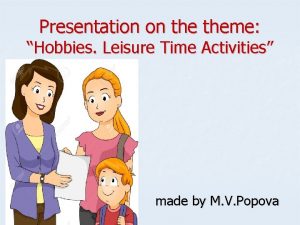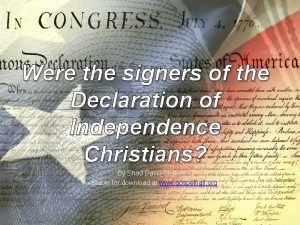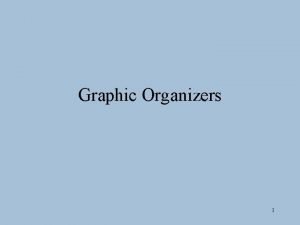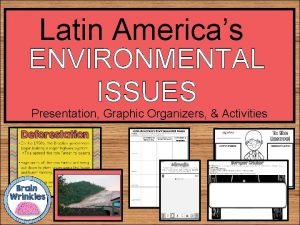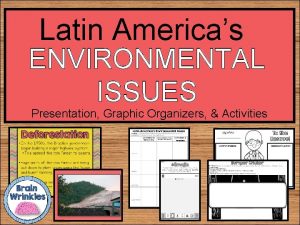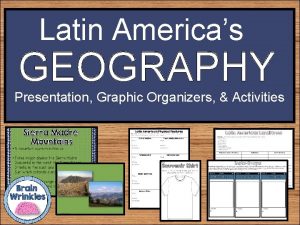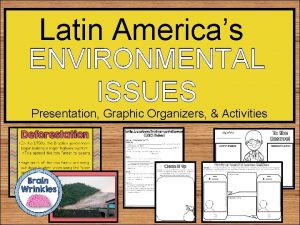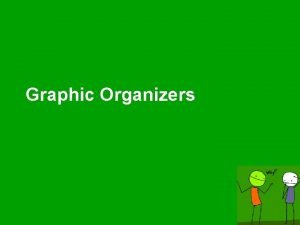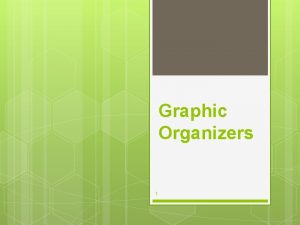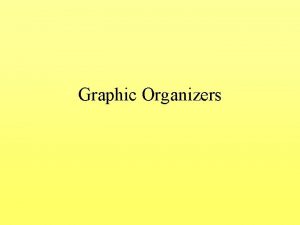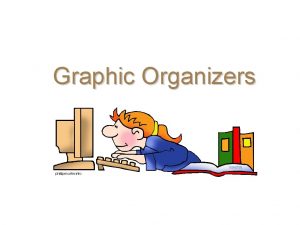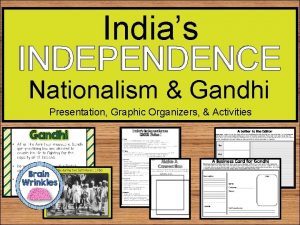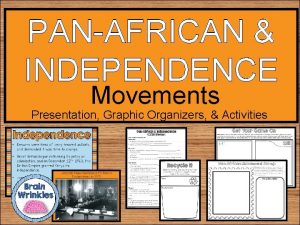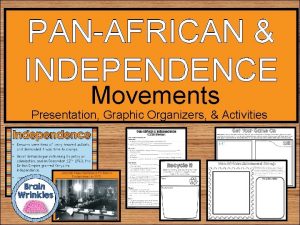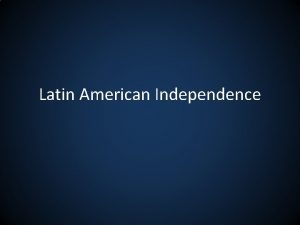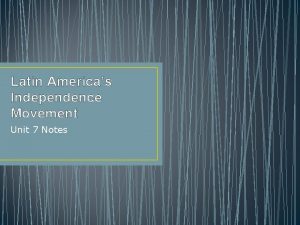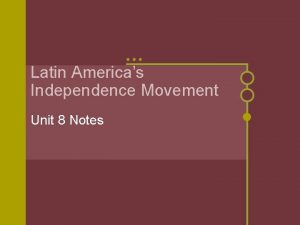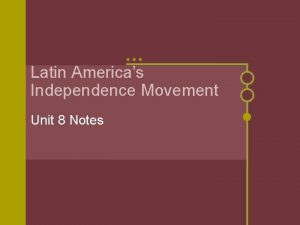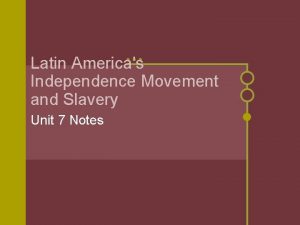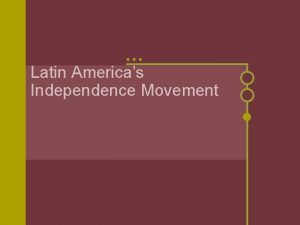Latin Americas INDEPENDENCE MOVEMENT Presentation Graphic Organizers Activities



















































































- Slides: 83

Latin America’s INDEPENDENCE MOVEMENT Presentation, Graphic Organizers, & Activities

STANDARDS: SS 6 H 2 The student will explain the development of Latin America and the Caribbean from European colonies to independent nations. c. Explain the Latin American independence movement; include the importance of Toussaint L’Ouverture, Simon Bolivar, and Miguel Hidalgo. © Brain Wrinkles

TEACHER INFO: CLOZE Notes • The next pages are handouts for the students to use for note-taking during the presentation. (Print front to back to save paper and ink. ) • Check the answers as a class after the presentation. © Brain Wrinkles

Independence Movement Notes 1 Colonies • European governments like ____________________ ruled most of Latin America for nearly 300 years. • They tightly controlled their colonies and ____________________ from the plantations and mines there. • By the end of the 18 th century, people living in the colonies grew restless and began calling for ____________________. Toussaint L’Ouverture: Childhood • Toussaint L’Ouverture ____________________ in the mid-1700 s. • His father was a ___________ who was captured and brought to the island of St. Domingue (now Haiti). • L’Ouverture learned to read and write and was interested in books about ____________________ for all men. Rebellion • St. Domingue was a rich colony full of huge coffee and ____________________. • French planters forced their slaves to work long hours under ____________________. • In 1791, a group of slaves led by ____________________ against their white masters, killing many colonists and burning the land. Slavery • During this time, France was also fighting a war against ____________________ forces in St. Domingue. • They couldn’t deal with slave rebellions, and in 1793, the French government ____________________. • After this victory, L’Ouverture took control of the country and ____________________ for life. French Control • France’s emperor, ________________ , was not happy with L’Ouverture’s self-imposed title. • In 1802, he sent a large army to re-establish _____________ of the island. • Their mission was to ____________________ , restore the Frenchled government, and regain control of the sugar trade. Capture • L’Ouverture’s army _______________ and lost. • L’Ouverture was invited to a meeting with a French general to discuss a peace treaty, but instead was ________and sent to France. • He was imprisoned and eventually ___________ in a French dungeon. © Brain Wrinkles

Independence Movement Notes 2 Independence • L’Ouverture’s army was outraged and took up arms again _______________. • In November 1803, they ____________________ forces. • In 1804, St. Domingue declared itself independent of French rule and was ____________. • Haiti became the ___________ in Latin America to break free of European imperialism. Simon Bolivar: Childhood • Simon Bolivar was born in 1783 in Caracas, Venezuela to a ____________________. • Bolivar had an ____________________ and, like L’Ouverture, read many books on freedom and equality. • While traveling in Italy, he discovered his life’s purpose: to ____________________ from European control. The Liberator • From 1810 to 1824, Bolivar ____________________ a number of South American countries, including Venezuela, Colombia, Ecuador, Peru, and Panama. • In 1824, he finally ____________________ and ended the country’s rule over South America. • He was nicknamed __________ and the country of Bolivia was named in his honor. Gran Colombia • Bolivar is often called the “George Washington of South America” because of his battle to ____________________ from Spanish control. • He declared himself dictator and tried to create a single, large South American country called __________. • ____________________ caused the different countries to break up into Colombia, Panama, Venezuela, and Ecuador. • Bolivar ____________________ in 1830. Miguel Hidalgo: Childhood • Miguel Hidalgo was born in 1753 in ______________ (now Mexico). • His family saw that he got a good education and he eventually trained to _____________. • While working among native people and peasants, he realized that there was ______________ in Mexico. • Those born in Spain got ______________ , compared to those born in Mexico. © Brain Wrinkles

Independence Movement Notes 3 Equality • Father Hidalgo began ____________________ against this unfair treatment. • He protested that slaves should be freed, land should belong to Mexican farmers and not Spanish ones, and that Spain should ____________________. • In 1810, Father Hidalgo decided to ____________________ and on September 6 th, he gave a famous speech called, ____________________, which set off Mexico’s independence movement. Defeat • ____________________ joined Hidalgo and marched to meet the Spanish in Mexico City. • The rebel group won several small victories, but in the end, they were _____________ for the Spanish forces. • The Spanish troops ____________________ and captured Father Hidalgo. • He was tried for ____________________ Independence • The war for Mexico’s ____________________ until after his death. • Mexico did not win its independence for another 10 years when Spain finally withdrew its last troops from ____________________. • Today, Hidalgo is known as the ____________________ © Brain Wrinkles

Independence Movement Notes 1 KEY Colonies • European governments like Spain and Portugal ruled most of Latin America for nearly 300 years. • They tightly controlled their colonies and gained enormous wealth from the plantations and mines there. • By the end of the 18 th century, people living in the colonies grew restless and began calling for independence from European rulers. Toussaint L’Ouverture: Childhood • Toussaint L’Ouverture born a slave in the mid-1700 s. • His father was a free African who was captured and brought to the island of St. Domingue (now Haiti). • L’Ouverture learned to read and write and was interested in books about freedom and equality for all men. Rebellion • St. Domingue was a rich colony full of huge coffee and sugarcane plantations. • French planters forced their slaves to work long hours under horrible working conditions. • In 1791, a group of slaves led by L’Ouverture rebelled against their white masters, killing many colonists and burning the land. Slavery • During this time, France was also fighting a war against Spanish and English forces in St. Domingue. • They couldn’t deal with slave rebellions, and in 1793, the French government abolished slavery. • After this victory, L’Ouverture took control of the country and declared himself dictator for life. French Control • France’s emperor, Napoleon Bonaparte, was not happy with L’Ouverture’s self-imposed title. • In 1802, he sent a large army to re-establish French control of the island. • Their mission was to dispose of L’Ouverture, restore the French-led government, and regain control of the sugar trade. Capture • L’Ouverture’s army fought the French and lost. • L’Ouverture was invited to a meeting with a French general to discuss a peace treaty, but instead was captured and sent to France. • He was imprisoned and eventually died alone in a French dungeon. © Brain Wrinkles

Independence Movement Notes 2 KEY Independence • L’Ouverture’s army was outraged and took up arms against France. • In November 1803, they defeated the last of the French forces. • In 1804, St. Domingue declared itself independent of French rule and was renamed Haiti. • Haiti became the 1 st country in Latin America to break free of European imperialism. Simon Bolivar: Childhood • Simon Bolivar was born in 1783 in Caracas, Venezuela to a very wealthy family. • Bolivar had an excellent education and, like L’Ouverture, read many books on freedom and equality. • While traveling in Italy, he discovered his life’s purpose: to liberate his homeland from European control. The Liberator • From 1810 to 1824, Bolivar fought to liberate a number of South American countries, including Venezuela, Colombia, Ecuador, Peru, and Panama. • In 1824, he finally defeated the Spanish and ended the country’s rule over South America. • He was nicknamed “The Liberator” and the country of Bolivia was named in his honor. Gran Colombia • Bolivar is often called the “George Washington of South America” because of his battle to free much of the area from Spanish control. • He declared himself dictator and tried to create a single, large South American country called Gran Colombia. • Fights among different groups caused the different countries to break up into Colombia, Panama, Venezuela, and Ecuador. • Bolivar died from tuberculosis in 1830. Miguel Hidalgo: Childhood • Miguel Hidalgo was born in 1753 in New Spain (now Mexico). • His family saw that he got a good education and he eventually trained to become a priest. • While working among native people and peasants, he realized that there was not equality in Mexico. • Those born in Spain got special treatment, compared to those born in Mexico. © Brain Wrinkles

Independence Movement Notes 3 KEY Equality • Father Hidalgo began speaking out against this unfair treatment. • He protested that slaves should be freed, land should belong to Mexican farmers and not Spanish ones, and that Spain should stop taxing Mexico’s citizens. • In 1810, Father Hidalgo decided to organize a revolt and on September 6 th, he gave a famous speech called, “Cry of Dolores”, which set off Mexico’s independence movement. Defeat • Thousands of people joined Hidalgo and marched to meet the Spanish in Mexico City. • The rebel group won several small victories, but in the end, they were no match for the Spanish forces. • The Spanish troops defeated the rebels and captured Father Hidalgo. • He was tried for treason and executed. Independence • The war for Mexico’s independence continued until after his death. • Mexico did not win its independence for another 10 years when Spain finally withdrew its last troops from Mexico in 1821. • Today, Hidalgo is known as the “Father of Mexican Independence”. © Brain Wrinkles

Latin America’s Independence Movements Toussaint L'Ouverture, Simon Bolivar, & Miguel Hidalgo © Brain Wrinkles

Colonies • European governments like Spain and Portugal ruled most of Latin America for nearly 300 years. • They tightly controlled their colonies and gained enormous wealth from the plantations and mines there. • By the end of the 18 th century, people living in the colonies grew restless and began calling for independence from European rulers. © Brain Wrinkles

© Brain Wrinkles

Toussaint L’Ouverture © Brain Wrinkles

Childhood • Toussaint L’Ouverture born a slave in the mid-1700 s. • His father was a free African who was captured and brought to the island of St. Domingue (now Haiti). • L’Ouverture learned to read and write and was interested in books about freedom and equality for all men. © Brain Wrinkles

© Brain Wrinkles

Rebellion • St. Domingue was a rich colony full of huge coffee and sugarcane plantations. • French planters forced their slaves to work long hours under horrible working conditions. • In 1791, a group of slaves led by L’Ouverture rebelled against their white masters, killing many colonists and burning the land. © Brain Wrinkles

© Brain Wrinkles

Slavery • During this time, France was also fighting a war against Spanish and English forces in St. Domingue. • They couldn’t deal with slave rebellions, and in 1793, the French government abolished slavery. • After this victory, L’Ouverture took control of the country and declared himself dictator for life. © Brain Wrinkles

© Brain Wrinkles

French Control • France’s emperor, Napoleon Bonaparte was not happy with L’Ouverture’s selfimposed title. • In 1802, he sent a large army to reestablish French control of the island. • Their mission was to dispose of L’Ouverture, restore the French-led government, and regain control of the sugar trade. © Brain Wrinkles

Capture • L’Ouverture’s army fought the French and lost. • L’Ouverture was invited to a meeting with a French general to discuss a peace treaty, but instead was captured and sent to France. • He was imprisoned and eventually died alone in a French dungeon. © Brain Wrinkles

Independence • L’Ouverture’s army was outraged and took up arms against France. • In November 1803, they defeated the last of the French forces. • In 1804, St. Domingue declared itself independent of French rule and was renamed Haiti. • Haiti became the 1 st country in Latin America to break free of European imperialism. © Brain Wrinkles

© Brain Wrinkles

Simon Bolivar © Brain Wrinkles

Childhood • Simon Bolivar was born in 1783 in Caracas, Venezuela to a very wealthy family. • Bolivar had an excellent education and, like L’Ouverture, read many books on freedom and equality. • While traveling in Italy, he discovered his life’s purpose: to liberate his homeland from European control. © Brain Wrinkles

© Brain Wrinkles

The Liberator • From 1810 to 1824, Bolivar fought to liberate a number of South American countries, including Venezuela, Colombia, Ecuador, Peru, and Panama. • In 1824, he finally defeated the Spanish and ended the country’s rule over South America. • He was nicknamed “The Liberator” and the country of Bolivia was named in his © Brain Wrinkles

© Brain Wrinkles

Gran Colombia • Bolivar is often called the “George Washington of South America” because of his battle to free much of the area from Spanish control. • He declared himself dictator and tried to create a single, large South American country called Gran Colombia. • Fights among different groups caused the different countries to break up into Colombia, Panama, Venezuela, and Ecuador. © Brain Wrinkles

© Brain Wrinkles

Miguel Hidalgo © Brain Wrinkles

Childhood • Miguel Hidalgo was born in 1753 in New Spain (now Mexico). • His family saw that he got a good education and he eventually trained to become a priest. • While working among native people and peasants, he realized that there was not equality in Mexico. • Those born in Spain got special treatment, compared to those born in Mexico. © Brain Wrinkles

© Brain Wrinkles

Equality • Father Hidalgo began speaking out against this unfair treatment. • He protested that slaves should be freed, land should belong to Mexican farmers and not Spanish ones, and that Spain should stop taxing Mexico’s citizens. • In 1810, Father Hidalgo decided to organize a revolt and on September 6 th, he gave a famous speech called, “Cry of Dolores”, which set off Mexico’s independence © Brain Wrinkles

Defeat • Thousands of people joined Hidalgo and marched to meet the Spanish in Mexico City. • The rebel group won several small victories, but in the end, they were no match for the Spanish forces. • The Spanish troops defeated the rebels and captured Father Hidalgo. • He was tried for treason and executed. © Brain Wrinkles

© Brain Wrinkles

Independence • The war for Mexico’s independence continued until after his death. • Mexico did not win its independence for another 10 years when Spain finally withdrew its last troops from Mexico in 1821. • Today, Hidalgo is known as the “Father of Mexican Independence”. © Brain Wrinkles

TEACHER INFO: Graphic Organizer • Print off the following page for each student. • They should complete the chart after discussing the presentation. © Brain Wrinkles

Independence Movement Leaders Directions: Complete the chart below after discussing the presentation. Who was the person? Toussai nt L’Ouvert ure Simon Bolivar Miguel Hidalgo © Brain Wrinkles What role did the person play? Symbol

Independence Movement Leaders Directions: Complete the chart below after discussing the presentation. Who was the person? Toussai nt L’Ouvert ure Former slave from Haiti Fought against France for slaves’ freedom – won; declared himself dictator of Haiti for life; fought against France and lost; imprisoned and died in France Wealthy Venezuelan who was educated in Europe Fought against Spanish rule in northern South America and won; nicknamed The Liberator; set up New Granada, which eventually became several countries; Bolivia was named after him Priest from Mexico who worked with the poor Began Mexico’s independence movement with Cry of Dolores; led a group of rebels against Spanish; lost and was executed; 10 years later, Mexico gained independence; Father of Mexico’s Independence Simon Bolivar Miguel Hidalgo © Brain Wrinkles What role did the person play? Symbol

TEACHER INFO: Independence Leader Selfie • Print off the Selfie handout for each student. • The students will “take” a selfie of one of the leader’s in action. Then, they will write about what happened during the event from the leader’s perspective. © Brain Wrinkles

Independence Leader Selfie Directions: Choose one of the leaders that we have studied. Create a “selfie” that this person could have taken after accomplishing a major event. Draw the selfie inside of the phone, and then write what happened during the event from the person’s point of view. Also, create a username for the person and write the actual date and location of the event. Don’t forget to hashtag the person’s thoughts and feelings about the event! © Brain Wrinkles

TEACHER INFO: A Spanish Spy Letter • Project the following slide onto the board. Each student will need a sheet of paper. • The students will write a letter from the perspective of a Spanish spy in Latin America. He/she will “spy” on the leaders and report the findings to the Spanish government. © Brain Wrinkles

A European Spy… You are a spy that was sent by the Spanish government to Latin America. Your mission is to look for suspicious people who may try to revolt against European countries. Write a letter to the Spanish government telling them about the three revolutionary leaders that you have found in Latin America. These men are a huge threat to Spain and other European empires, so make sure you include a lot of information about these leaders. Hints: Who are they? Where are they located? What are they trying to do? Why are they against European control? Dear Spanish Official, … © Brain Wrinkles

TEACHER INFO: Rate-A-Leader • Give each student a copy of the Rate A Leader handout. • The students will create a review page for one of the leader’s in Latin America’s Independence Movement. • They will need to write: • Description of the leader – What’s his background? How did he fight for independence? Was he successful? • Customer review from someone who liked him • Customer review from someone who disliked him • *Project the slide with red directions so that the students know what goes in each section. © Brain Wrinkles

Rate-A-Leader Description: Leader: Picture Or Symbol Location: _________ What is the leader’s background? How did he contribute to the independence movement in Latin America? Customer Reviews Date: ___________ By ___________ from ______________ What would a person who liked the leader say about him? Why? How many stars would he give? What would a colonist who disliked the leader say about him? Why? How many stars would she give? © Brain Wrinkles

Rate-A-Leader Description: Leader: Location: _________ Customer Reviews Date: ______ By ______ from _______ © Brain Wrinkles Date: ______ By ______ from _______

TEACHER INFO: Leader Business Card • Print off Business Card template for each student. • The students will choose one of the leaders of Latin America’s independence movement and create a business card for him. © Brain Wrinkles

Leader Business Card Directions: Create a business card for one of Latin America’s independence movement leaders. Include the person’s job description, awards or honors, and past experiences on the card. Also, create a logo (symbol) and a catchy symbol. Description: _____________________________ _____________________________ Awards: _____________________________ Past Experience: _____________________________ _____________________________ © Brain Wrinkles Logo Name: _____________ Company: ___________ Email: _____________ Slogan: _______________________________________________________________

TEACHER INFO: Who Am I? Review • Print off the cards on the following page and glue them back to back. • Project the “Who Am I? ” statements and have the students hold up the correct end of the card. • After you scan to see the students answers, display the “I Am…” answer slide. © Brain Wrinkles

L’Ouverture Bolivar © Brain Wrinkles All Hidalgo © Brain Wrinkles

Who Am I? The country of Bolivia was named in my honor. © Brain Wrinkles

I Am… Simon Bolivar © Brain Wrinkles

Who Am I? I am known as the Father of Mexican Independence. © Brain Wrinkles

I Am… Miguel Hidalgo © Brain Wrinkles

Who Am I? I was able to end Spanish rule in much of South America. © Brain Wrinkles

I Am… Simon Bolivar © Brain Wrinkles

Who Am I? I was imprisoned & died in France. © Brain Wrinkles

I Am… Toussaint L’Ouverture © Brain Wrinkles

Who Am I? I am a wealthy Venezuelan who was educated in Europe. © Brain Wrinkles

I Am… Simon Bolivar © Brain Wrinkles

Who Am I? I was a Catholic priest in Mexico. © Brain Wrinkles

I Am… Miguel Hidalgo © Brain Wrinkles

Who Am I? I helped citizens gain independence in Haiti. © Brain Wrinkles

I Am… Toussaint L’Ouverture © Brain Wrinkles

Who Am I? I fought for freedom from European rule. © Brain Wrinkles

I Am… All 3 © Brain Wrinkles

Who Am I? Colombia, Ecuador, Panama, and Peru won their independence through my efforts. © Brain Wrinkles

I Am… Simon Bolivar © Brain Wrinkles

Who Am I? I am a former slave who was self-educated. © Brain Wrinkles

I Am… Toussaint L’Ouverture © Brain Wrinkles

Who Am I? I am the only one of the 3 who lived to see my country gain independence. © Brain Wrinkles

I Am… Simon Bolivar © Brain Wrinkles

Who Am I? I believe in freedom and equality for all. © Brain Wrinkles

I Am… All 3 © Brain Wrinkles

Who Am I? My nickname is “The Liberator”. © Brain Wrinkles

I Am… Simon Bolivar © Brain Wrinkles

TEACHER INFO: Triple Venn Diagram • Print off the Venn Diagram for each student. • The students will work with partners to compare and contrast the three leaders of Latin America’s independence movement. © Brain Wrinkles

INDEPENDENCE MOVEMENT Bolivar Compare and Contrast © Brain Wrinkles Hidalgo L’Ouverture

TEACHER INFO: TICKET OUT THE DOOR • Have students write 3 -5 “clues” about one of the leaders from this lesson. • The next day, begin class by having students share their clues and have their peers guess the person. You can do this in partners, groups, or with the entire class. © Brain Wrinkles

Name: Who Am I? On the name tag below, write 3 -5 clues about one of the leaders that we have studied. Don’t write the person’s name because your classmates are going to guess who it is based on your description! HELLO My name is… © Brain Wrinkles

Thank You! Thank you so much for downloading this file. I sincerely hope you find it helpful and that your students learn a lot from it! I look forward to reading your feedback in my store. If you like this file, you might want to check out some of my other products that teach social studies topics in creative, engaging, and hands-on ways. Best wishes, Ansley at Brain Wrinkles

Terms of Use © 2016 Brain Wrinkles. Your download includes a limited use license from Brain Wrinkles. The purchaser may use the resource for personal classroom use only. The license is not transferable to another person. Other teachers should purchase their own license through my store. This resource is not to be used: • By an entire grade level, school, or district without purchasing the proper number of licenses. For school/district licenses at a discount, please contact me. • As part of a product listed for sale or free by another individual. • On shared databases. • Online in any way other than on password-protected website for student use only. © Copyright 2016. Brain Wrinkles. All rights reserved. Permission is granted to copy pages specifically designed for student or teacher use by the original purchaser or licensee. The reproduction of any other part of this product is strictly prohibited. Copying any part of this product and placing it on the Internet in any form (even a personal/classroom website) is strictly forbidden. Doing so makes it possible for an Internet search to make the document available on the Internet, free of charge, and is a violation of the Digital Millennium Copyright Act (DMCA). Thank you, Ansley at Brain Wrinkles Clipart, fonts, & digital papers for this product were purchased from:
 The americas in the age of independence
The americas in the age of independence Tea blank graphic organizers
Tea blank graphic organizers Blank graphic organizers for math staar
Blank graphic organizers for math staar Supplemental aids
Supplemental aids Define graphic organizer
Define graphic organizer Mcas universal accommodations
Mcas universal accommodations Generalization and example pattern organizer
Generalization and example pattern organizer Blank graphic organizers for math staar
Blank graphic organizers for math staar Marzanos strategies
Marzanos strategies Mcas accommodations
Mcas accommodations Quebec's independence movement worksheet answer key
Quebec's independence movement worksheet answer key Quebec independence movement political cartoon
Quebec independence movement political cartoon Simon bolivar toussaint louverture
Simon bolivar toussaint louverture Latin american people win independence
Latin american people win independence Latin american peoples win independence
Latin american peoples win independence Latin american peoples win independence
Latin american peoples win independence Latin american peoples win independence
Latin american peoples win independence Latin american peoples win independence
Latin american peoples win independence Latin american peoples win independence
Latin american peoples win independence Non sequitur transition
Non sequitur transition Ghost graphic story graphic and wayfinding
Ghost graphic story graphic and wayfinding Cues, questions, and advance organizers
Cues, questions, and advance organizers Narrative advance organizer
Narrative advance organizer Expository advance organizers examples
Expository advance organizers examples Dear organizers
Dear organizers Discourse organizers
Discourse organizers Marzanos 9
Marzanos 9 Cues questions and advance organizers
Cues questions and advance organizers Skimming advance organizer examples
Skimming advance organizer examples The statement of cash flows helps users
The statement of cash flows helps users It is a popular indoor and outdoor sport
It is a popular indoor and outdoor sport Primary and support activities
Primary and support activities Definition of primary activities
Definition of primary activities Movement and non-movement area
Movement and non-movement area Locomotor movements dance
Locomotor movements dance Spanish caste system in the americas
Spanish caste system in the americas Spanish colonization of the americas
Spanish colonization of the americas Soroptimist international of the americas
Soroptimist international of the americas Art of the americas before 1300
Art of the americas before 1300 Ib history of the americas study guide
Ib history of the americas study guide European colonization of americas
European colonization of americas Declaración sobre seguridad en las américas 2003
Declaración sobre seguridad en las américas 2003 Spanish cast system
Spanish cast system Americas guardians mc
Americas guardians mc Centro internacional de convenciones
Centro internacional de convenciones The beginning of our global age europe and the americas
The beginning of our global age europe and the americas Transversal de las americas
Transversal de las americas Abl americas
Abl americas Chapter 24 the americas and oceania
Chapter 24 the americas and oceania Chapter 24 new worlds the americas and oceania
Chapter 24 new worlds the americas and oceania Chapter 24 new worlds the americas and oceania
Chapter 24 new worlds the americas and oceania Chapter 20 the americas and oceania
Chapter 20 the americas and oceania The beginnings of our global age europe and the americas
The beginnings of our global age europe and the americas Chapter 10 global cuisine 1 the americas
Chapter 10 global cuisine 1 the americas Open door policy cartoon
Open door policy cartoon Ingenieria
Ingenieria The americas on the eve of invasion
The americas on the eve of invasion State building in the americas
State building in the americas Americas global position
Americas global position Chapter 2 exploring the americas study guide
Chapter 2 exploring the americas study guide Chapter 2 exploring the americas answer key
Chapter 2 exploring the americas answer key Asociación de supervisores bancarios de las américas
Asociación de supervisores bancarios de las américas Rochem
Rochem Network reliability and security
Network reliability and security Chapter 16 people and empires in the americas
Chapter 16 people and empires in the americas Define boxer rebellion
Define boxer rebellion International gateway of the americas
International gateway of the americas Corporate risk minds
Corporate risk minds Dkms zmiana danych
Dkms zmiana danych Cómo se enseña
Cómo se enseña Wholesale itf
Wholesale itf Hteamericas
Hteamericas Doric columns in america
Doric columns in america Geonetcast americas
Geonetcast americas Geo
Geo Blood donation form
Blood donation form Hte americas
Hte americas Chris penwell
Chris penwell Sixty in latin
Sixty in latin Leisure time presentation
Leisure time presentation Why is it called latin america
Why is it called latin america 5cm labor
5cm labor 4 maneuvers of leopold
4 maneuvers of leopold What does the declaration of independence say
What does the declaration of independence say
